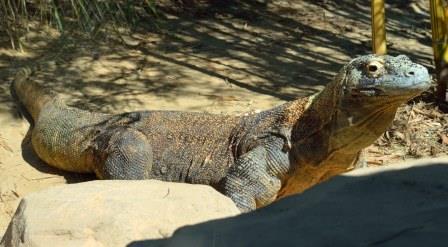The Komodo dragon (Varanus komodoensis) is a predatory reptile belonging to the family Varanidae (comprising the monitor lizards) in the order Squamata. This creature is indigenous to a small number of Indonesian islands, including Komodo, Rinca, and Flores, and is the last living member of a relic population of large lizards that formerly ranged throughout Indonesia and Australia. The animal is notable as the largest living lizard in the world. Komodo dragons have been known to attain a maximum length of 3 m (10 ft). Individuals have been found to weigh up to 136 kg (300 lb), but a more typical weight is 70–80 kg (154–176 lb). Although the Komodo dragon has no natural predators, it is currently listed as a vulnerable species, according to the International Union for Conservation of Nature (IUCN) Red List of Threatened Species. Approximately 4000–5000 individuals are located in the wild; most are found within the confines of the Komodo National Park in Indonesia. The main threats to the species' survival include habitat destruction (especially from the detrimental effects of logging), human interference (through the toll from poaching on the lizards' main prey, deer), declines in the number of breeding females, and limitations resulting from its restricted range. See also: Endangered species; Evolution and interrelationships of lizards and snakes; Island biogeography; Reptilia; Squamata

The Komodo dragon is a powerful carnivorous predator. In general, the dragon relies on its superior sense of smell to detect its food. It devours carrion and live prey, and is capable of ingesting up to 80% of its body weight in a single feeding episode. Komodo dragons feed predominantly on mammals, including small rodents and shrews, and full-size individuals are capable of killing large deer, water buffalo, and boars. They also eat birds, snakes, and other lizards. When searching for prey, the Komodo dragon will typically use stealth and camouflage while awaiting its prey. Then, the lizard will use its strength to overwhelm the prey, and its extremely sharp teeth and claws to tear apart its victim. See also: Animal camouflage; Olfaction; Predator-prey interactions
In addition, there have been indications that the lizard's saliva contains a very high amount of toxic bacteria (some studies have detected more than 50 deadly bacterial strains). It has been suggested that even if a prey animal escapes after being bitten by a Komodo dragon, it will still die of blood poisoning within 24 hours because of the highly toxic bacteria transferred into the wound from the lizard's saliva. Recent studies dispute that theory, however. Other reports have instead indicated that the Komodo dragon has venom glands in its jaw. Toxic substances found in the lizard's venom have been observed to prevent blood clotting and to lower blood pressure, and they might serve to weaken, if not kill, bitten prey. Conclusive results are not yet available, so more definitive analyses are needed to determine the nature and toxic mechanisms of the venom transferred in the dragon's bite. See also: Bacteria; Oral glands; Physiological ecology (animal); Poison; Poison gland; Toxin





